
Planning
On October 26, 1965, as Pleime had just been liberated, Colonel Hieu made plan for an exploitation operation in the pursuit of the two withdrawing NVA regiments to the Chupong-Iadrang complex.
He immediately foresaw the possibility of annihilating the B3 Field Front forces with B-52 airstrikes because of a stroke of luck in intelligence gathering about the military situation of the enemy troops by the hours and by the days.
Amidst all the methods of intelligence gathering, there was the radio intercepts of open communications in Mandarin between the Chinese Advisors at regimental level and divisional level. These Chinese Advisors discussed in the open on everything: logistics, personnel, troop unit locations, movements, morale, status, losses, casualties, cadres’ intentions, and planning. When the Chinese Advisors talked, Colonel Hieu listened in. When they stopped talking, he relied on other methods of intelligence gathering.
In Pleime, cuộc chię́n lịch sử, page 94, Colonel Hieu stated unequivocally that the victory achieved in the Pleime counteroffensive into Chupong-Iadrang complex was due to the acquisition of a solid intelligence on the enemy situation:
The battle from phases 2 and 3 also introduced an aspect never seen up to now because for almost 20 years, during the Franco-Vietnamese war, seldom pursuit operation was considered after each time the enemy made appearance and when it was conducted, no significant results had been achieved. Therefore this time around, the determination not to allow the enemy to escape, coupled with the solid intelligence on the enemy situation had permitted the battle to develop to maximum degree and scale and at the same token lead to the biggest victory ever achieved by the ARVN and its Allied. So with the certainty of getting a plethora of ongoing and updated by the days of solid intelligence on the enemy military situation, Colonel Hieu draw up his operational plan of using Arc Lite to destroy the enemy en mass at Chupong-Iadrang complex.
His objective was to be able to nudge B3 Field Front into an attack posture which would require the three regimental units to cluster into respective staging areas in preparation for movement to attack; at that precise brief moment of a less than 24 hour window of opportunity, they would be closed enough that the center of mass would become targetable for B52 airstrikes.
His plan would have the following elements of diversionary moves:
Colonel Hieu then submitted his operational plan and its feasibility to MACV/General Westmoreland for approval.
Execution
The next step was to set up a coordination team comprising the II Corps, the Air Cav Forward Command Post, the First Field Force and MACV.
The execution of the plan and the determination of timing for starting of each of the three diversionary moves relied on the assessment of intelligence data of Colonel Hieu. The orders issued to the Field Commander/General Knowles were assumed by General Larsen in three occasions:
I. ONE
- On Oct 27, for the herding operation (1st Air Cav Brigade)
II. TWO
- On Nov 8, for the enticement operation (3rd Air Cav Brigade)
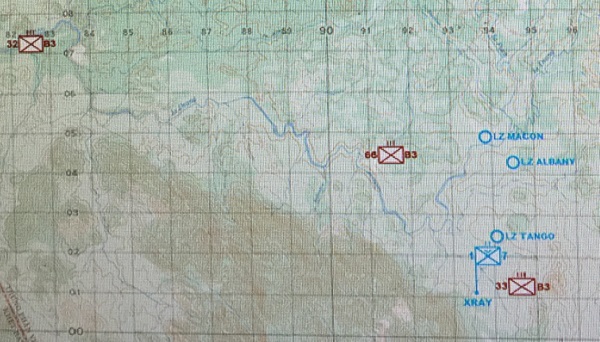
III. THREE
- On Nov 12, 1/7 Air Cav Battalion was ordered to make plan to air assault Chu Pong massif (for the distractive operation)
- and Nov 14, for the distractive operation (1/7 Air Cav Battalion)
On Nov 15, at noon, B-52 air strikes began at B3 Field Front forces (center of mass vicinity YA8702) and continued for 5 days, until 11/19 (Why Pleime, chapter VI):
For five consecutive days, from 15 to 19 November, the giant B52 bombers had flown a total of 96 sorties. One after the other, the areas of the Chu Pong massif - each of 20 square miles - underwent a systematic earthquake spreading from West to East. VC bunkers and trenches which so far had resisted the strikes by tactical aircraft and artillery began to score direct hits by the 750-pound bombs. The heavy canopy of the jungle ceased to be effective in both concealment and cover. The "back door" into Cambodia was closed and to escape, the VC remnants were reduced to utilize the narrow valley of the Ia Drang.
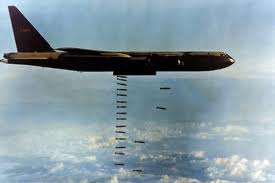
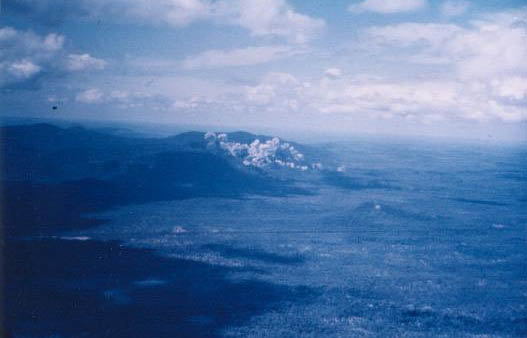
Enemy casualties as results of Arc Lite operation amounted to about 2,000 dead.
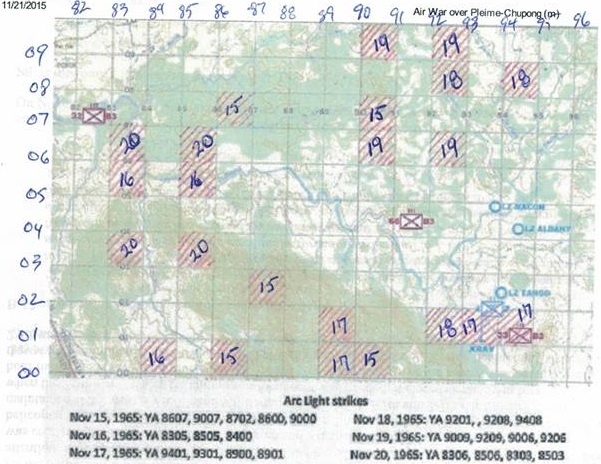
On November 15 and 16, B-52 airstrikes aimed mainly at the positions of units of the 33rd and 32 Regiment; on November 17, 18 and 19, units of the 66th Regiment; and on November 20, units of the 32nd Regiment. ̣
The "coup de grâce" surgical strike was finished off by the Airborne Brigade ending the Pleime counteroffensive on November 26, 1965
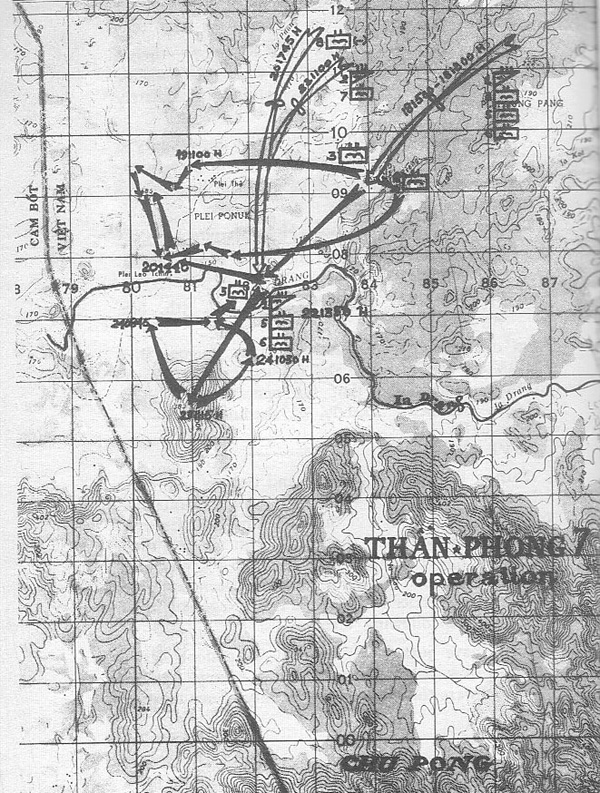
Nguyen Van Tin
8 January 2012
- Operation Pleime-Chupong B-52 Strike?
- The Use of B-52 Strike in Ia Drang Campaign, General Westmoreland’s Best Kept Military Secret
- Air War Over Pleime-Chupong
- Arc Light over Chu Pong Operation
- Catching a Thief Tactic in Pleime Campaign
- Pleime/Chupong Campaign Destroying B3 Field Front Base
- The Uniqueness in Pleime Counteroffensive Operational Concept
- Pleime Counteroffensive into Chupong Iadrang Complex
- The Unfolding of Strategic and Tactical Moves of Pleime Campaign
- Battle of Pleime
- The Truth about the Pleime Battle
- Intelligence Gathering at Ia Drang
- Intelligence, the Key Factor in the Pleime Campaign's Victory
- Roll Call of Combatants at Pleime-Chupong-Iadrang Battlefront
- "Victory at Pleime" ?
- Tactical Moves in Pleime Battle
- Kung Fu Tactics at Pleime Campaign
- Various Diversionary Moves in Support of Arc Lite Strike in Pleime Counteroffensive
- What if there was no master plan for Pleime Counteroffensive?
- Pleime/Chupong Campaign Destroying B3 Field Front Base
- A Few Things You Should Know about Pleime-Iadrang Campaign
- Things the VC Don't Want People To Know at Pleime Battle
- Reviewing "Why Pleime"
- Review of "Intelligence Aspects at Pleime_Chupong Campaign"
- Perplexing Maneuvers at Pleime-Chupong-Iadrang You Might Be Attempted to Question
- A Bird’s-Eye-View of Pleime Campaign
- Operation Dan Thang 21
- US Air Force’s Roles in Pleime Campaign
- Arc Lite Operation Planning and Execution in Pleime Offensive
- A Doctrinal Lesson on the Use of Arc Lite in Pleime Counteroffensive
- Command and Control of Arc Light Strike at Chupong-Iadrang
- A Military Genius in Action at Pleime-Chupong-Iadrang Battlefront
- Command and Control Skills in Pleime Campaign
- Behind-the-scenes Activities at Various Allied Headquarters During Pleime Campaign
- The Two Principals Players Of Pleime Chess Game
- Pleime Battle's Diary
- Pleime Campaign and Pleiku Campaign
- A New Look at Ia Drang
- Operation Long Reach
- LZ X-Ray Battle (General Knowles)
- My Contributions to the Battle of Ia Drang in Wikipedia
- Operation LZ X-Ray
- Colonel Hal Moore’s Self-Aggrandizement in “We Were Soldiers Once ... and Young”
- Colonel Hal Moore Misunderstood his Mission at the Ia Drang Battle
- What Historians Failed to Tell About the Battle at LZ X-Ray
- Hal Moore and 1/7th Air Cavalry Battalion's Real Mission at LZ X-Ray
- Two Different Narrations of LZ X-Ray Battle by II Corps
- Ia Drang Valley Battle? Which One?
- LTC Hal Moore Summoned to a Woodshed Session?
- Colonel Hieu's Operational Concept for LZ X-Ray
- LZ Albany Battle - Chinese Advisors' Perspective
- A Puzzling Air Assault Performed by 1/7 Air Cavalry at LZ X-Ray
- Two Different Narrations of Than Phong 7 Operation by II Corps
- General Schwarzkopf's Naďveté In Ia Drang Battle
- Venturing into Lion's Den in Ia Drang Valley
- American Perspective of Pleime Battle
- General Kinnard's Naďveté in Pleime Campaign
- "No Time for Reflection at Ia Drang" ?
- Pleime Campaign or Pleime-Ia Drang Campaign?
- A Critique of General Bui Nam Ha's Opinions about Plâyme Campaign
- Commenting on General Nguyen Huu An's Account of Plâyme Campaign
- Crushing the American Troops in Western Highlands or in Danang?
- What Really Happened at Ia Drang Battle
- Case Study of a Typical Misinterpretation of Ia Drang Battle
- Ia Drang Battle Revisited
Documents
- Why Pleime
- Pleime, Trận Chię́n Lịch Sử
- Pleime Battle Viewed From G3/I Field Force Vietnam
- Long Reach Operation Viewed From G3/I Field Force Vietnam
- LZ X-Ray Battle and LZ Albany Battle Viewed From G3/I Field Force Vietnam
- Than Phong 7 Operation Viewed From G3/I Field Force Vietnam
- Arc Light Strike at Chupong-Iadrang Viewed From G3/IFFV
- Pleiku Campaign
- Intelligence Aspects at Pleime_Chupong Campaign
- Excerpts of General Westmorland’s History Notes re: Pleime-Chupong-Iadrang Campaign
- LZ X-Ray Battle (General Knowles)
- LZ X-Ray After Action Report - LTC Hal Moore and Colonel Hieu
- Than Phong 7
- 52nd Combat Aviation Battalion in Support of Pleime Campaign
- CIDG in Camp Defense (Plei Me)
- Viet Cong Requested Red China's Aid
- Battle of Duc Co
- NVA Colonel Ha Vi Tung at Pleime-LZ Xray-LZ Albany
- The Fog of War: The Vietnamese View of the Ia Drang Battle
- No Time for Reflection: Moore at Ia Drang
- 1st US Cavalry Division Gives Support in the Battle at Plei Me
- Plei Me Fight Stands As War Turning Point
- Plei Me Battle
- Seven Days of Zap
- Pleime Through New York Times' View
- First Engagement With American Troops at Pleime-Iadrang
- Pleime Campaign
- Crushing the American Troops in Central Highlands
- NVA 66th Regiment in Pleime-Ia Drang Campaign
- The Political Commissar at the First Battle Against the Americans in Central Highlands